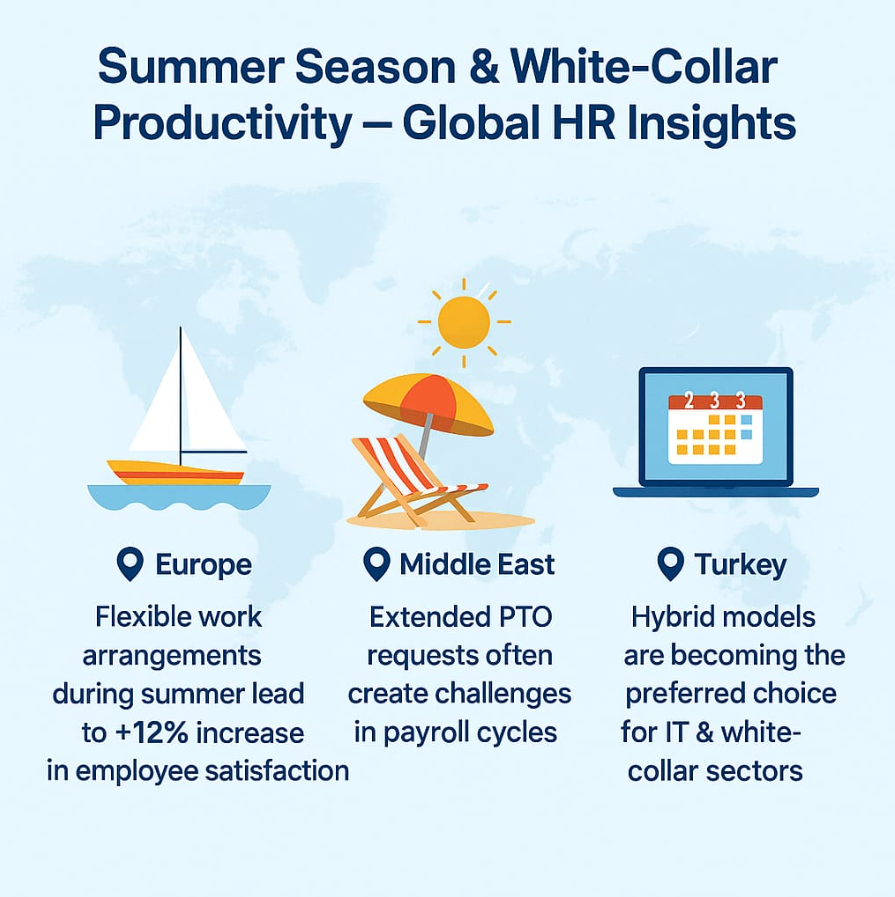
Chief Financial Officer (CFO)

Return-to-Office Season

Global breakdown of Paid Time Off (PTO) and summer leave trends in Summer (June–August), backed by recent research and statistics:

- Summary Table: Summer PTO Trends by Region
Region / Market June–Aug PTO Uptake & Duration Trends & Key Statistics
United States
- July is peak (approx. 37 % of annual vacations)
- PTO usage dropped: only ~30 % took a full week off per year in 2024
- Nearly 50 % expect to leave unused PTO by year-end
- Major reasons: workload (43 %), staffing gaps (24 %)
United Kingdom / Europe
- ~50 % of UK workers took a full week off in 2024 vs ~30 % US
- Europe mandates ~20 days statutory leave plus public holidays
- In 2022, ~71% Europeans planned summer vacations; many take 3–5 week blocks
- Statutory mandates in countries like Norway require ~15 consecutive days off between July–September
Asia (e.g. Japan, South Korea)
- Average entitlement in Japan is 10–20 days/year; often underused (~7 unused)
- PTO concentrated around festivals (e.g. Obon in August); generally shorter bursts than continuous summer holidays
Global / Cross-Region Trends
- Many workers feel guilty or uneasy taking PTO, especially in summer
- “Unlimited PTO” policies are rising but often result in fewer days taken, not more
📌 2. Additional Insight Highlights

Major PTO spike in July (~37 % of annual vacations) aligns with Independence Day .
Full-week leave usage remains low: just 30 % in 2024 vs 50% in the UK .
PTO bank shrinking over the years: average annual allowance dropped from ~34.5 days in 2019 to ~25.5 days in 2024; unused PTO fell from ~25.4 to ~14.9 days .
Nearly half of U.S. workers report they will not use all their PTO in 2024 .
Common barriers: workload concerns (43%), desk coverage issues (24%), organizational stigma and manager discouragement also prevalent .

European workers take more leave: statutory minimum ~20 days plus public holidays (ranging up to 38 days total in countries such as Austria/France/Spain).
Cultural norm: taking 3‑5 consecutive weeks off during summer, typically July–August .
2022 data shows 71 % planned summer vacations in Europe, up from 57 % in 2021 .
🌏 Asia (Japan, South Korea)
Legal entitlement varies: Japan mandates 10–20 days depending on tenure; South Korea up to 31 days total (including public holidays).
PTO clustered around fixed festivals (e.g. Obon in August), with shorter leave intervals rather than long continuous summer breaks.
🌐 Global Patterns
Workers increasingly feel uncomfortable taking vacation, especially in busy seasons—the proportion requesting PTO fell 18 % year-over-year, approvals down 9 %.
Despite popularity, unlimited PTO correlates with lower actual usage, not higher.
🧭 3. Strategic Implications for Employers
In the U.S., anticipate heavy July demand and plan staffing support accordingly.
In Europe, align PTO policies with cultural norms and statutory leave blocks—teams often expect extended leave during July–August.
In Asia, factor in clustered leave patterns around local holidays and festivals (e.g. Obon in Japan).
Globally, design PTO policies and encourage usage to overcome cultural reluctance, especially when unlimited plans produce underuse.
Proactive strategies like manager encouragement, planned PTO coverage, and clear communication can reduce leave guilt and boost uptake.